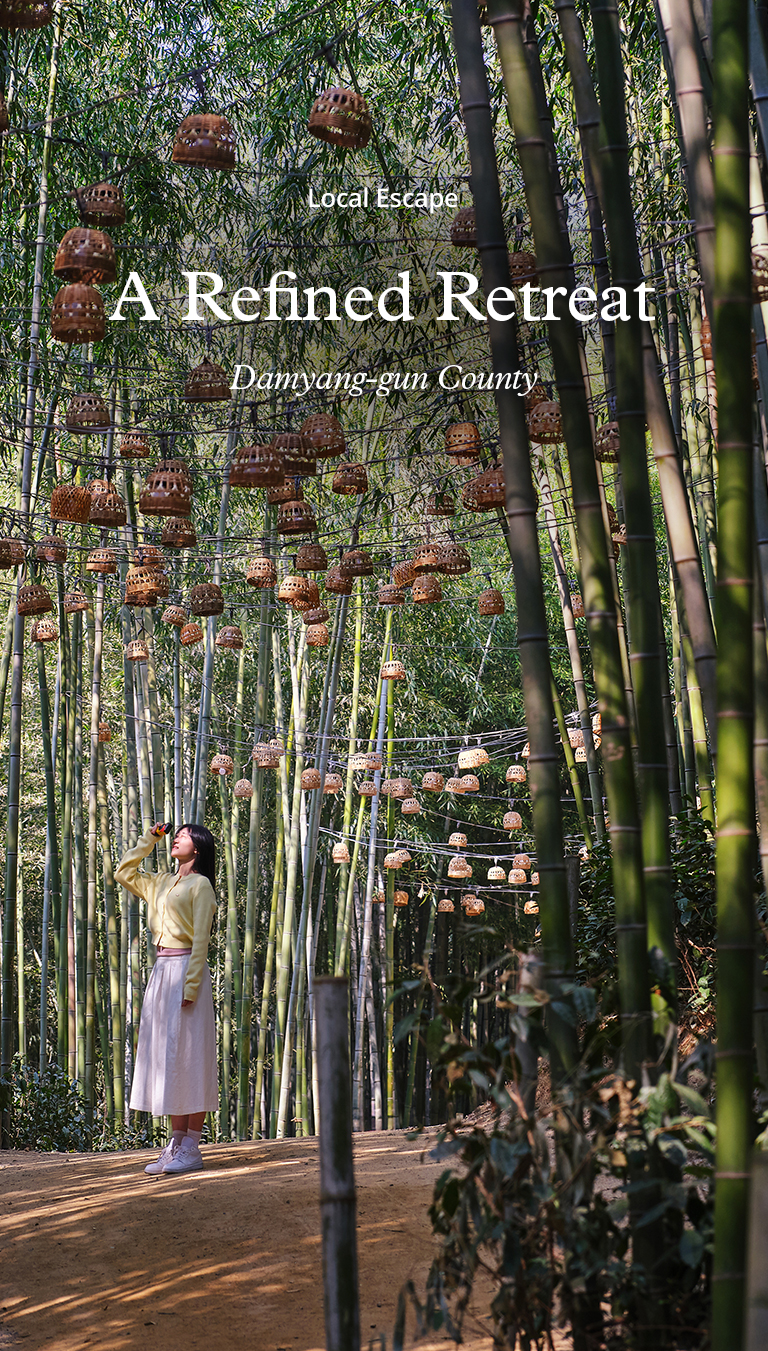
The Korean term pungnyu refers to the pursuit of refinement and the rejection of the ordinary. Sometimes that’s just what we need to elevate ourselves from the monotony of daily life. By escaping the constant hustle and everyday concerns, one can find solace in Damyang-gun County in Jeollanam-do Province, a place where elegance and tranquility await.
Writer. Yeo Ji Hyo
It takes about three and a half hours to drive from Seoul Station to the contemplative county of Damyang, which is regarded as having some of Korea’s finest natural and ecological attractions. Even back during the Joseon Dynasty (1392–1910), scholars often visited the area to partake in refined activities, such as poetry recitation and academic inquiry. Damyang was the ideal location to rest, a refuge from more secular concerns.
A favorite destination for many scholars seeking landscapes that would inspire inner peace was Soswaewon Garden. The garden was built by Yang San-bo, a scholar from the Joseon Dynasty, who abandoned his career in the government after his mentor lost his life in factional strife. Upon entering the garden, one might wonder whether the landscape of Soswaewon—which means “pure and clean garden”—was beautiful enough to heal Yang’s wounded soul.
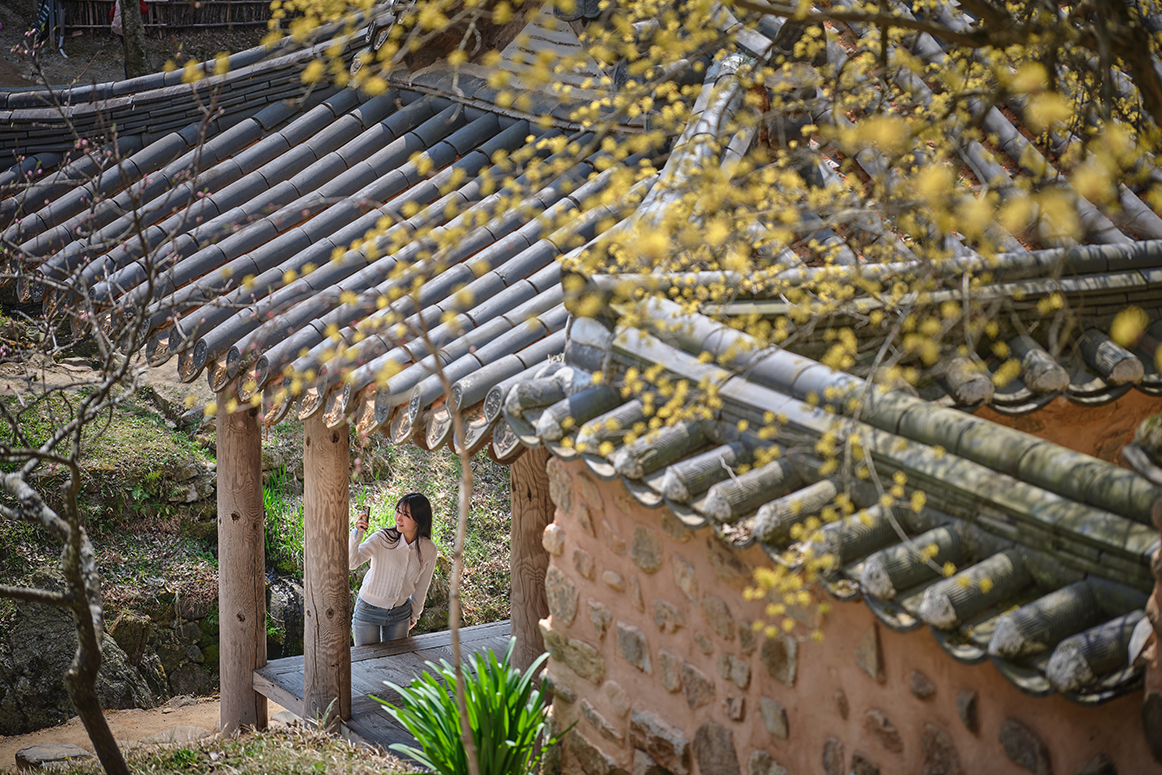 Soswaewon Garden, established in the 1500s during the Joseon Dynasty
Soswaewon Garden, established in the 1500s during the Joseon Dynasty
In an instant, it’s like stepping onto a bamboo-lined path reminiscent of a portal into another world. The path soon leads to a cluster of picturesque pavilions overlooking a small ravine that runs from east to west. Standing upon a pavilion, visited by many over the years, reveals that nothing is out of place. Natural features and human creations—all are in harmony, each element occupying its proper place.
Soswaewon is an authentic representation of traditional Korean gardens, which seek to minimize manmade features while maximizing the natural terrain. Walls are built of rocks and dirt, knolls are not leveled, and water is allowed to flow in its original channels. In fact, a wall is built above the ravine to ensure that the stream here remains intact. A tendency to respect and value nature is evident throughout the site.
First-time visitors to Soswaewon often struggle to contain their sheer delight. The rippling melody of the water flowing through the ravine and the dappled hues of green—best experienced on a spring day—offer an enchanting spectacle. The scene’s exquisite beauty can feel like a dream, making it easy to spend endless hours entranced by its glory. Apparently a poem was written about spending all four seasons at Soswaewon. That’s hardly surprising, since it’s the kind of place that could inspire anyone to express their thoughts in verse.
Soswaewon isn’t the only private garden in the area. Visitors are also welcome at Sigyeongjeong Pavilion, Chwigajeong Pavilion, Myeongokheon Garden, Songgangjeong Pavilion and Myeonangjeong Pavilion, all dating back to the Joseon Dynasty. Tender moments can be had at Sigyeongjeong, which can be glimpsed between the pine trees on the broad shores of Gwangjuho Lake, and at Myeongokheon, a placid pond reflecting the rapturous landscape around it. There can be no doubt: Damyang still has the charm that drew scholars of the past.
서울역에서 차로 3시간 30분, 온전한 사색의 시간이 기다리고 있는 담양에 도착했다. 담양은 한국 여행지 중에서도 생태 자연이 대단한 곳으로 손꼽히는 곳이다. 그 때문일까? 예로부터 담양은 풍류를 즐기기 위해 조선시대 학자들이 많이 찾았다고 한다. 자연 속에서 시를 읊고 학문을 닦는 것이 풍류라 여겼던 그들에게, 담양은 속세에서 벗어나 쉴 수 있는 장소로서 최적의 선택지였던 것이다.
그들이 평화를 얻고자 마주했던 풍경을 찾아 소쇄원으로 향했다. 조선시대 학자인 양산보가, 그의 스승이 정치적인 일로 죽임을 당하자, 출세에 뜻을 접고 내려와 세운 곳이란다. ‘소쇄’가 맑고 깨끗하다는 뜻이라는데, 과연 그의 마음을 제대로 치유해 줄 만큼 풍경이 맑고 아름다웠을지 수백 년 전 장면을 상상하며 내부로 발길을 옮긴다.
일순간 다른 세상으로 통하는 길이 열리는 듯, 대나무 숲길이 펼쳐진다. 대나무들이 만든 길 끝에, 남북으로 가로지르는 작은 계곡, 계곡을 마당 삼아 온 사방의 풍경을 즐길 수 있는 정자들이 드러난다. 이곳을 거쳐 갔던 사람들이 오래간 머물렀을 정자에 섰다. 눈에 닿는 어느 것 하나 부자연스러운 것이 없다. 자연물이며 인공물들이 있어야 할 자리에 있는 것처럼 모든 것들이 조화롭다. 소쇄원은 인공적인 조경을 최소화하여 자연 있는 그대로를 최대한 살리는 한국 정원 양식의 원형이 잘 보존된 곳이다. 흙과 돌로 담을 쌓고, 언덕은 깎지 않았다. 물 흐름 하나도 바꾸지 않고 되레 계곡 위에 담장을 세워 물길을 그대로 유지했다. 자연을 존중하고 소중히 여기는 태도가 곳곳에서 묻어났다.
소쇄원을 막 방문한 사람들의 감탄이 여기저기서 울려 퍼진다. 봄날에만 만날 수 있는 여린 녹색 빛에 둘러싸인 채, 졸졸 흐르는 계곡의 음률에 마음을 맡긴다. 꿈에도 나올 것만 같은 아름다운 장면이다. 언제까지고 한없이 시간을 보낼 수 있을 것만 같다. 소쇄원에서 보낸 사계절을 주제로 한 시도 있다는데, 이곳이라면 정말로 시 한 편이 술술 읊어질 만하다. 선비들이 담양을 그렇게 찾은 이유가, 아직 사라지지 않고 바로 여기 있음을 확인한다.
Leaving behind the gardens dotted with pavilions, the journey continues to downtown Damyang. One of the things Damyang is most associated with is bamboo trees, a connection that goes back for centuries. Since the Goryeo Dynasty (918–1392), locals have been planting bamboo trees in season and brewing bamboo alcohol.
Given the high quality of bamboo items, bamboo craft became highly developed in Damyang. The bamboo forest called Juknokwon in the middle of Damyang is where craftspeople once gathered the bamboo they needed for their work. Over time, bamboo goods were largely replaced by manufactured goods often made of plastic, so craftsmen stopped visiting the forest. In the early 2000s, the county government transformed the area into a place for rest and relaxation.
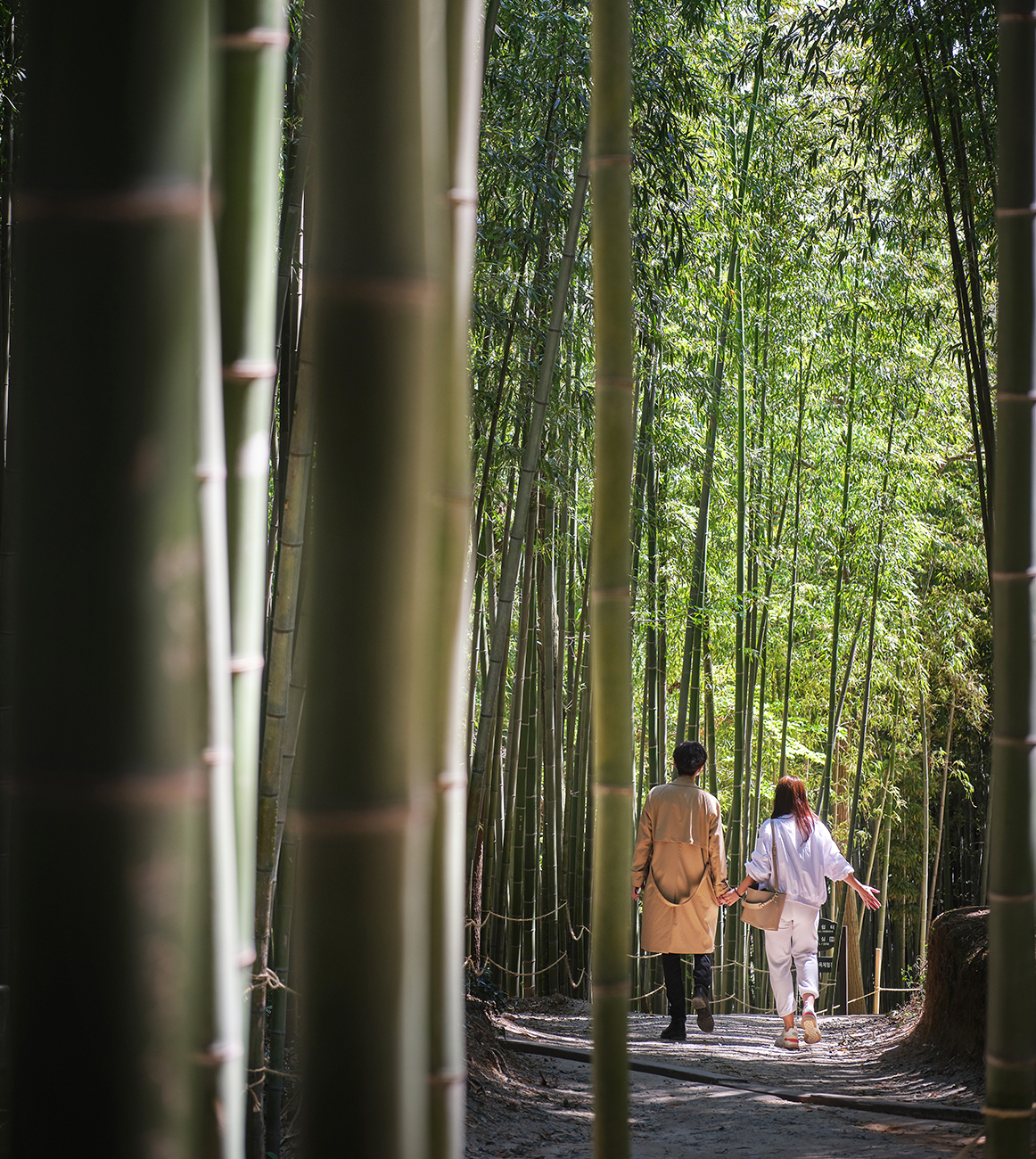 Juknokwon is a bamboo-filled forest in Damyang. Its year-round greenery means you can visit anytime to enjoy a breath of fresh air.
Juknokwon is a bamboo-filled forest in Damyang. Its year-round greenery means you can visit anytime to enjoy a breath of fresh air.
The bamboo trees of Juknokwon span an area measuring around 31 hectares. Upon stepping into the forest, a refreshing breeze brushes against the skin. One might imagine feeling the breath of the bamboo trees that stretch up toward the sky high above. While walking through the woods, sunbeams slant through the trees, casting lovely shadows upon the ground. Beneath the bamboo trees are rows of adorable tea bushes in various hues of green that are easy on the eyes.
Just strolling through the forest feels like an immense luxury. From the observation point at the entrance, the trails run for about 2.2 kilometers. There are eight trails altogether, with names like Lover’s Lane and Philosopher’s Way. Some trails go past waterfalls, while others run through somber groves filled with trees much larger than the bamboo. A leisurely walk through this multifaceted bamboo forest is so pleasant that it comes as a surprise to learn an hour and a half has already passed.
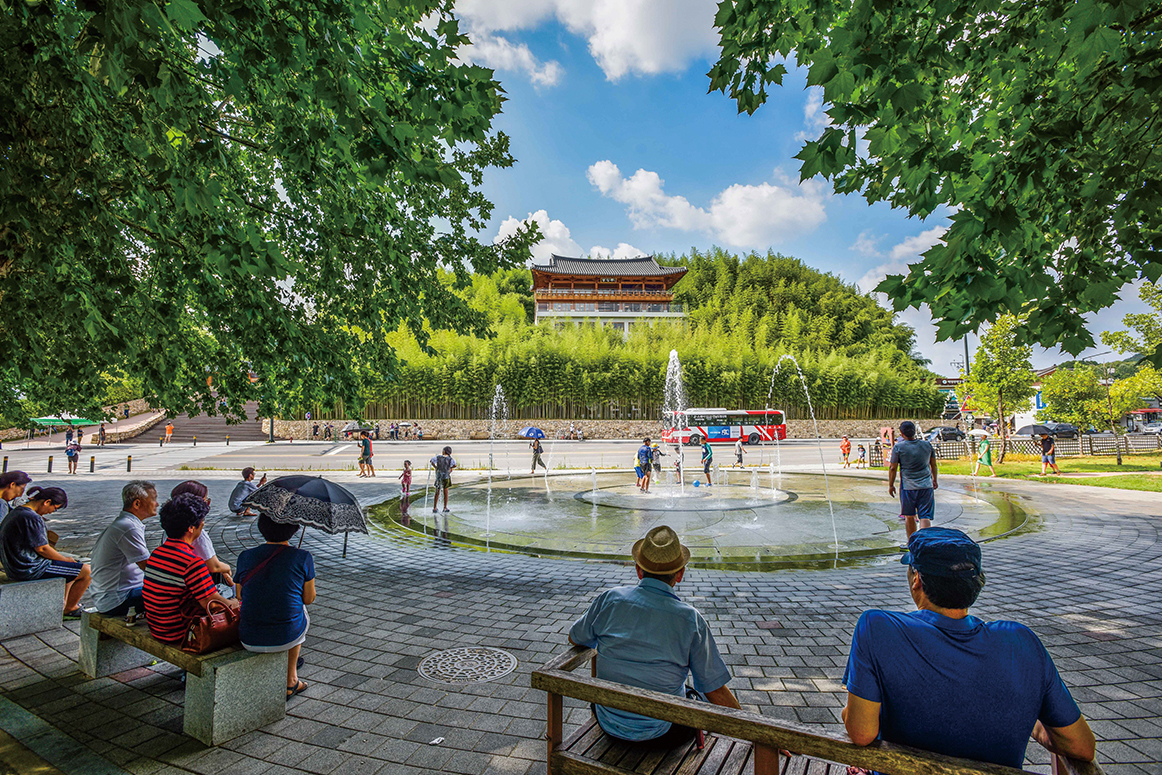 Juknokwon is located next to Gwanbangjerim Forest. In the park between them, fountains run in summer. / © Korea Tourism Organization.
Juknokwon is located next to Gwanbangjerim Forest. In the park between them, fountains run in summer. / © Korea Tourism Organization.
At the far end of the trail stands the Siga Culture Village. The village hosts several life-sized recreations of the pavilions from the gardens, which played such a formative role in Korea’s literary history. With its close-cropped lawns, this area has a more refined and polished charm than either the gardens or the bamboo forest. A bamboo sunbed provides the perfect spot to bask in the warm sun and gentle breeze.
After emerging from Juknokwon, a brief stop is made by the stream flowing beside it. Next is Gwanbangjerim Forest, where some of the area’s most popular hiking trails are found. The huge trees in this forest anchor an embankment that was erected to stop the stream from flooding.
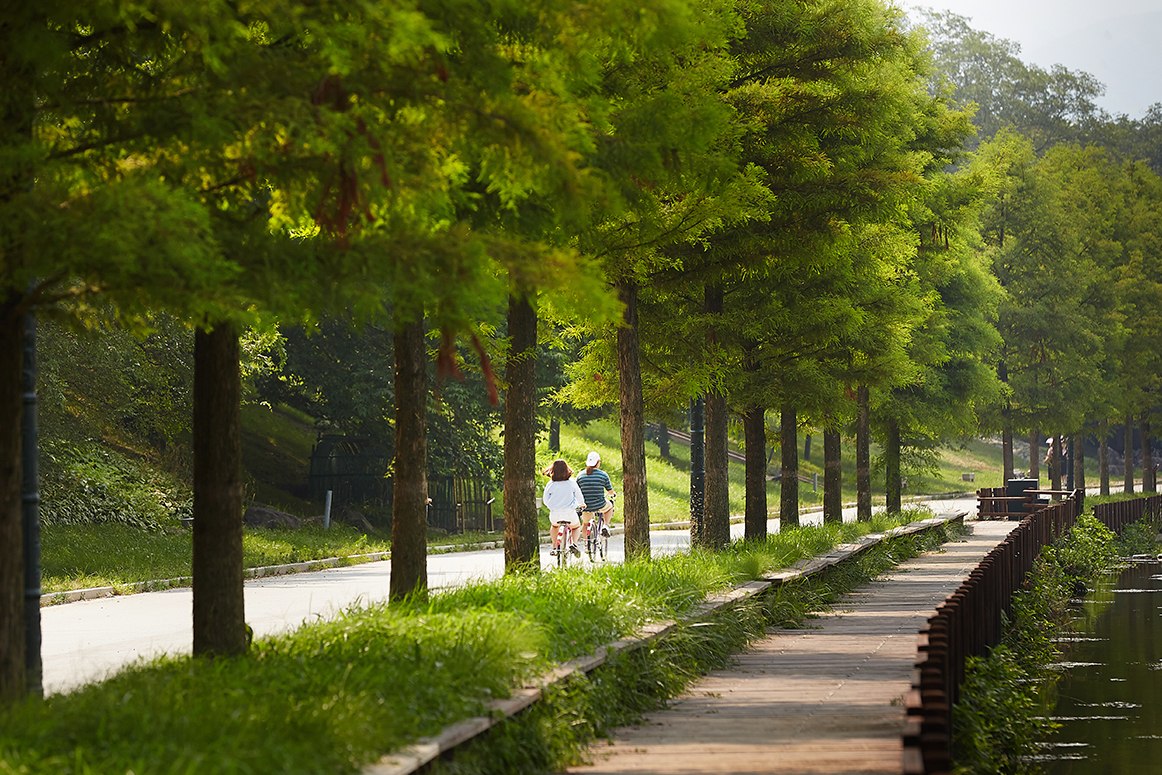 Gwanbangjerim Forest is adjacent to a road, making it ideal for enjoying the scenery while cycling.
Gwanbangjerim Forest is adjacent to a road, making it ideal for enjoying the scenery while cycling.
After passing Gwanbangjerim Forest, the sweet fragrance of meat grilling over charcoal becomes noticeable. Tteokgalbi, a dish originating in Jeollanam-do Province, is what fills the air. After exploring Damyang, an energy boost seems essential. Tteokgalbi (grilled short rib patties) is made of beef short ribs that are minced and pounded into succulent patties, served alongside daenamutongbap (steamed rice in bamboo tube)—a dish of steamed rice mixed with chestnuts and jujubes stuffed inside bamboo sections. The subtle sweetness and fragrance of the rice go superbly with the short rib patties—truly a match made in culinary heaven.
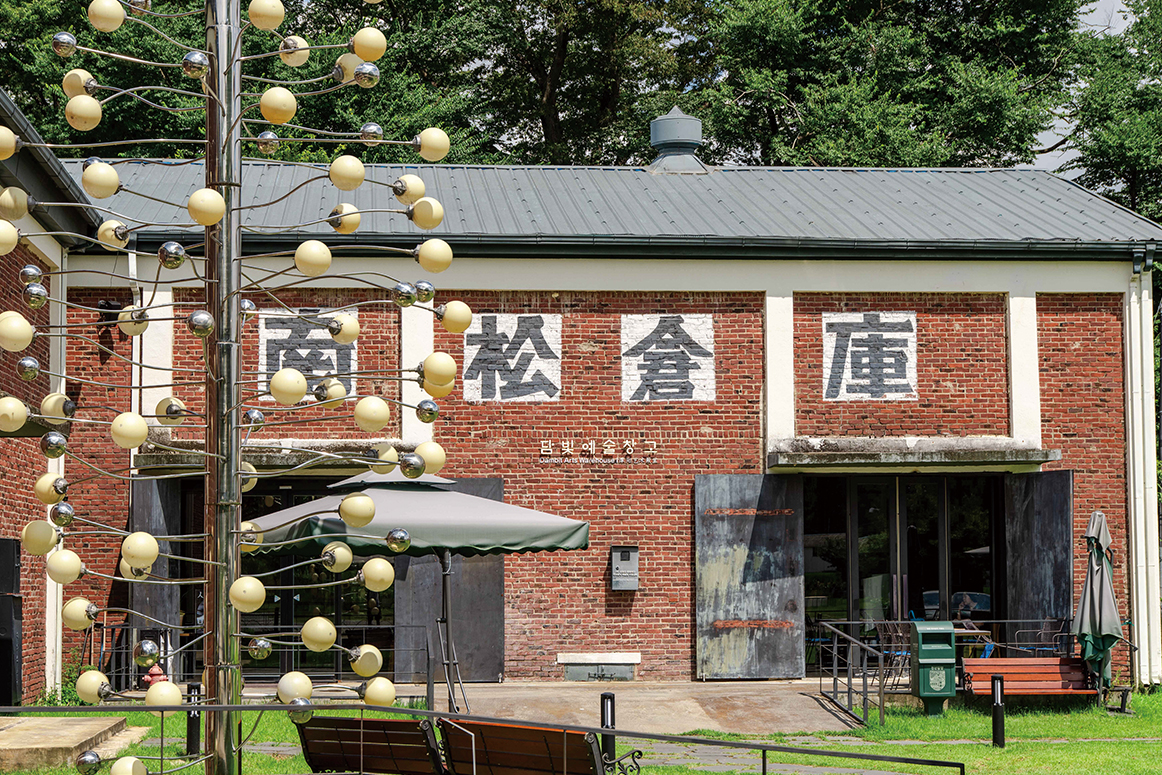 Dambit Arts Warehouse is a creative village for local artists and a cultural space where visitors can relax and enjoy. / © Korea Tourism Organization.
Dambit Arts Warehouse is a creative village for local artists and a cultural space where visitors can relax and enjoy. / © Korea Tourism Organization.
Damyang is an emerald-toned retreat, a place where Koreans throughout the ages have found peace of mind by connecting with nature. Thanks to a dedicated effort to preserve that ancient charm, people in 2025, hundreds of years later, still take comfort in the area’s cultural refinement. Damyang plants a seed of courage in the heart. Upon returning to daily routines, each day can be lived to the fullest while reflecting on the sights of Damyang—and looking forward to another visit someday.
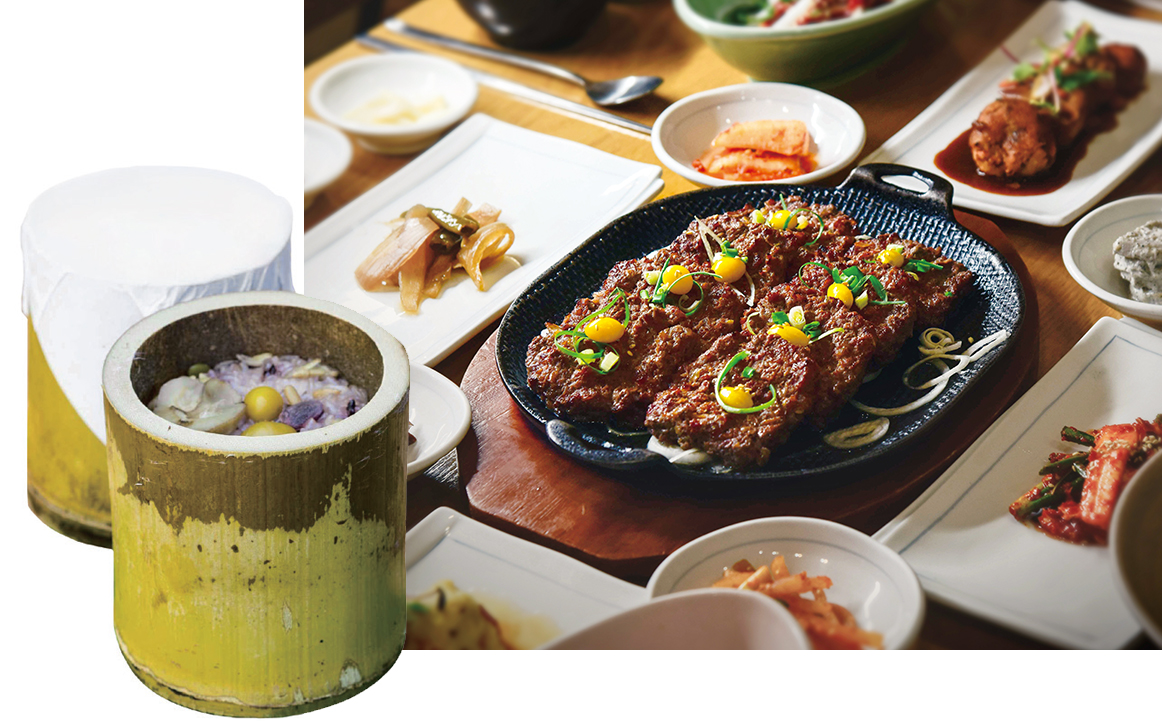 Damyang’s signature dishes: tteokgalbi, daenamutongbap and various side dishes. / © Korea Tourism Organization.
Damyang’s signature dishes: tteokgalbi, daenamutongbap and various side dishes. / © Korea Tourism Organization.
정자가 모여있는 일대를 뒤로하고, 담양의 도심으로 이동한다. 담양 하면 가장 먼저 떠오르는 ‘대나무’를 즐기기 위해서다. 담양은 과거부터 대나무와 연이 깊다. 고려시대 때부터, 대나무가 잘 자라는 시기에는 주민 모두가 대나무를 심고, 대나무로 담근 술을 마셨다. 대나무를 이용해 만든 물품 또한 무척이나 품질이 좋아, 담양에서는 죽공예 산업이 크게 발달했다.
담양 한가운데에 있는 대나무 숲, 현재의 죽녹원은 담양 주민들이 죽제품을 제작하기 위해 대나무를 채집하던 숲이었다. 시간이 지나며 플라스틱 같은 공산품이 죽제품을 대체하게 되어 사람의 발길이 점점 줄어들었지만, 군청에서 공간을 재조성하여 2000년 초반, 대나무숲은 휴식과 웰빙을 위한 장소로 다시 태어났다.
약 31만 m²의 부지가 대나무로 가득하다. 죽녹원에 들어서는 순간, 가장 먼저 시원하고 맑은 공기가 피부에 닿는다. 그 높은 하늘에 닿을 듯 길게 뻗은 대나무들이 뿜어내는 숨결이다. 한 걸음 한 걸음 옮길 때마다 햇빛이 나무 사이를 비집고 들어온다. 땅에 비추는 나무 그림자가 멋스럽다. 대나무 밑에 가득한 귀여운 차나무는 서로 다른 녹색들을 자랑하며 보는 이의 눈을 편안하게 해준다.
걷기만 해도 호사스러운 길이다. 입구에 있는 전망대를 기준으로 약 2.2 km의 산책로가 있다. 철학의 길, 사랑의 길 등 8개 주제의 길이 있다. 중간에 폭포를 만나는 곳도 있고, 앞서 만난 대나무보다 굵고 높은 나무들로 가득 차 엄중한 분위기가 느껴지는 곳도 있다. 다방면의 얼굴을 한 대나무 숲을 즐기며 천천히 걷다 보면, 어느새 한 시간 반이 훌쩍 지난다.
산책로가 끝나는 지점에는 시가문화촌이 기다리고 있다. 앞서 만났던 한국 문학의 산실인 여러 정원의 정자가 실제 크기로 복원되어 한 데 모여있으니, 반가운 느낌이다. 대나무 숲이나, 각 정원에서 만났던 것과는 또 다른 단정한 매력이 느껴진다. 얇고 부드러운 잔디, 그 위에 놓인 대나무 선베드에 누워, 지나가는 바람과 따뜻한 햇살을 잠시 즐긴다.
죽녹원에서 나와, 그 앞을 가로지르는 천 앞에 서본다. 이곳 또한 만인이 사랑하는 산책길로, 관방제림이라 불린다. 홍수를 방지하고자 세운 둑을 보호하기 위해 가로수를 심으며 만들어졌다. 아이가 된 듯 신나는 마음으로 천을 가로지르는 돌다리를 건너 관방제림을 지난다.
이윽고 달콤한 냄새와 함께 숯불 향이 코를 간지럽힌다. 전남 지역을 중심으로 시작된 떡갈비를 굽는 냄새다. 담양 구석구석을 보느라 열심히 체력을 보충할 차례다. 갈빗살을 곱게 다진 뒤 떡을 만들 듯이 매를 쳐서 만들어 연하고 부드러운 맛이 일품이다. 대나무를 그릇 삼아, 밤이며 대추 같은 열매를 쌀에 섞어 쪄냈다. 대통밥이 머금은 은근한 단맛과 향이 떡갈비의 맛과 무척 잘 어울린다. 언젠가 또 생각날 만큼 매력적인 조합이다.
온통 초록으로 가득했던 담양이다. 담양에서 수백 년 전 사람들은 마음을 정돈하고 자연을 벗삼아 매일을 지냈다. 담양이 모습을 고이 잘 간직한 덕에, 수백 년 후인 2025년의 사람들 또한, 풍류를 맛보며 위안을 얻는다. 그런 담양이 마음에 용기라는 이름의 씨앗을 남겼다. 일상으로 돌아가 담양에서의 풍경을 곱씹으며 씩씩하게 매일을 살아낼 준비를 한다. 또 다음, 담양에 올 날을 자연스레 그리며.